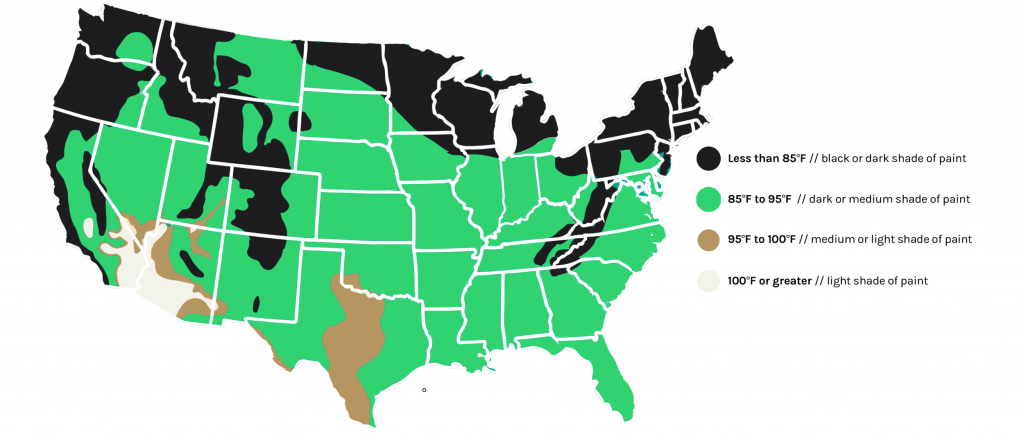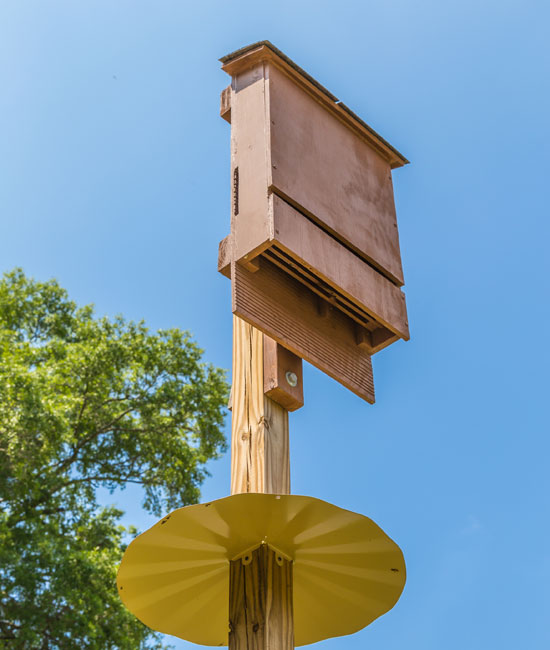

We’re here to help! Wild Yards is a completely free website that is 100% dedicated to helping you create a wildlife-friendly, sustainable yard. Read more
WildYards is reader-supported. When you buy a product through a link on our site, we may earn a comission. Every product is independently selected by our (obsessive) editors and our reviews are unbiased and objective. Read more about our mission or our privacy policy.
Finding the perfect installation spot for your bat house isn’t easy. Bats are notoriously picky when it comes to finding roosts.
If you’re not careful with your bat house placement, you may never live to see a bat call your bat box home.
But don’t worry, by the end of this guide you’ll know exactly where to hang a bat house for the best chance of attracting bats to your backyard.
If you’re reading this and haven’t yet bought a bat house, check out our guide on buying the best bat house kit. If you already have one, make sure the bat box you have is of high-quality. You want a bat box made with quality material so it lasts more than one season, has the correct dimensions to dissuade predators, and has the correct shape.
Let’s get started learning where to hang a bat house for the best results:
Near a Water Source
Like all creatures, bats require water to live. A colony of bats will usually roost near a natural source of water like a pond, stream, or lake.
If you have a natural source of water within 1,500 feet of your property, you’re in luck and you’ll be able to attract more bats than you could ever imagine. A natural source of water provides two benefits: a source of hydration and a food source since water also attracts insects.
But don’t worry if you don’t live near a natural water source, you can still attract more bats than you think by providing an artificial water source such as a bird bath or fish pond.
In regards to bat house placement, you want to mount the bat box at least 20 feet from the shore of any natural water source.
Avoid the Tree Line
The trees in your backyard will play a big part in determining your bat box placement.
It may be unintuitive, but bats don’t like to be near tree branches. Why not? Well, predators such as owls and hawks live in tree branches. Tree branches also cast shadows which can change the temperature of your bat box.
Being relatively close to a tree line (within 30-50 feet) is a plus, however.
Ideally, you want to install a bat house at least 20 feet from the nearest tree or tree line. You never want to mount the bat house on an actual tree.
Have Some Sun Exposure
Bats like to be warm and prefer the internal temperature of a bat box to be between 80-100 degrees so you should try and hang your bat box where it can receive sunlight for 6 to 8 hours.
Two things determine the internal temperature of a bat box: sun exposure and paint color.
How much sun exposure and what color your bat box should be painted is determined by where you live.
- Zone 1: Less than 85 degrees // direct sunlight for 6 to 8 hours // black or dark shade of paint
- Zone 2: 85-95 degrees // direct sunlight for 6 to 8 hours // dark or medium shade of paint
- Zone 3: 95 – 100 degrees // direct sunlight for 6 to 8 hours // medium or light shade of paint
- Zone 4: 100 degrees or higher // direct sunlight for 6 hours // light shade of paint
Not sure what zone you’re in? Check out the bat zone map below:

To get the best sun exposure and internal temperature, mount your bat house facing SE or SW. Either direction will provide 2-8 hours of direct sunlight, ample enough to warm the bat house to the ideal temperature.
Note: temperature is even more important if you want to attract nesting female bats. Baby bats aren’t as resistant to cold as adult bats.
Ideal Bat House Mounting Height
Bat houses should be mounted 15-20 feet off the ground. This provides enough height to deter ground-dwelling predators such as cats and raccoons. If you can mount the bat box on a 20 foot pole or post, that is ideal.
Mount the Bat House on a Pole or on a Building
As we mentioned earlier, you don’t want to know mount a bat house on a tree or a branch. It’ll provide too much shade and not enough safety from predators.
What does that leave us? The best place to hang a bat house is on a pole or a building. Buildings are less versatile than poles, because, obviously, you can’t move a building to match the ideal bat roosting requirements. But if your house or barn has a mounting area fits all the requirements (15-20ft off the ground, 20 ft from the nearest tree line and water source, and faces south-east or south-west) then go ahead and mount the bat house on your building.
Just make sure you don’t mount it anywhere above a door entrance or patio, near outdoor lights, or air blowing appliances like air conditioners and exhausts.
Since most buildings won’t perfectly match the requirements, we recommend mounting your bat houses on 20 foot poles or posts. They’re easy to move to find the perfect spot and you’ll be able to observe the bats from inside your home.

Where to Hang a Bat House: The Perfect Spot Guidelines
Given what we learned earlier, the perfect place to hang a bat house is:
- Near a water source, but at least 20 feet from the shoreline.
- At least 20 feet away from the nearest tree line or large freestanding tree
- Facing southeast or southwest where it’ll get 6-8 hours of direct sunlight
- 15-20 feet off the ground
- On a pole, post, or building
And you want to avoid these things:
- Mounting the bat box on a tree
- Placing it near heavily trafficked areas
- Placing it near artificial lighting
- Placing it where it’ll be exposed to smoke or bursts of air
How Long Does It Take For Bats to Roost in a Bat House?
Bats are wild animals and even if you find the perfect spot for your bat house, it’s no guarantee that they’ll make it their home.
Ideally, you want to install your bat box in early spring and following all the guidelines above. If you don’t have any roosting bats within the first year, experiment with different placements and sun exposure as temperature regulation is the most common reason for failure to roost.
We don’t recommend checking for bats by shining a light in the bat house. The easiest way to figure out if your bat house is inhabited is to check for bat guano (poop) below the mounting area. Or, wait until sunset and see if any bats come and go from the roost.

We have old telegraph poles on our property. Their placement sounds like they would work, and we should have bats in the neighborhood. The poles are taller than 20 feet. Could we mount two or three boxes on a pole?
And I know there is a horned owl that sometimes roosts on the poles, but there is no nesting going on. Is that a problem? I like having the owls around too. Is there a way to have both?
Is a dead tree (a snag) OK for bat house mounting?
Hi Craig,
It depends on how high the dead tree is and if there are any trees surrounding the snag. You also want to make sure that the post receives adequate sunlight.
Ideally, you want to mount the bat house on a pole or a building.
Hello Mr. Frankson! Thanks for a great article, very informative. My question is what is the reasoning for positioning a bat house at least 20 feet from a shoreline? I have spoken to other bat pro’s and they do not seem to share that concern. I am interested in what you determine the downside to doing so. Thank You!
Hello Steve,
It’s simply to protect the bat house from inclement weather and from being washed away by waves or flooding. Overall, it’s for preventative measures more than anything else.
We have had a bat problem for 3 years in Tulsa Oklahoma. The bat is roosting behind a hanging speaker on the ceiling 0f our back porch. We have been spraying animal repellent which works for a few days and then it returns. The speaker is located in a corner where there is minimal sunlight and no water source other than the Arkansas river which is about 1/4 mile away. I would like to try the bat house but have no idea where to hang it. We have fenced in back yard with no only shrubs and a garden.
Hi there’s been a little brown bat that has been around my house for a long time. It kinda follows me around. Once I came in my back door after it flew around above my head in my backyard and when went back out there it was on my house above my backdoor. Lol I kinda thought that was nice that he followed me so I gave him a name. Ever year one comes back in the spring its a little brown one so I assume it’s the same one. Now I found it on the roof of our deck. We live in the mountains in a cabin in TN. It gets between the wood and the metal roof on our deck. Is it possible it’s the same bat? Will it hurt my wooden deck floor? One last ? Is it possible for one to get attached to a person? I’m kind of an animal person. I have a cardinal that follows me and began for food and I also have a big mouth cat fish that is in our two acre bass lake I call Charlie and every day in the afternoon I can go by the lake and call Charlie and he swims to the bank looking for me to feed him.
I know you may not believe me but I have pictures and plenty witnesses.
I believe you, Janice!
Can a bat house be posted onto a purple martin pole?
Hi!
Yes, a bat house can be posted onto a purple martin pole!
Hi Robert, can you speak a bit more about guano, how much one can expect from the inhabitants in the bat house, whether it is safe for plants and grass, and any other guano considerations? Thank you so much!
I should also add, does it collect under the bat house only, or does it get everywhere in the vicinity? Thanks!
Hi Charity,
The bat guano will collect under the bat house and usually will form into a pile. However, natural elements like rain, wind, and sun will naturally break down the guano. Bat guano is actually high in nitrogen and makes a great fertilizer so you can put a flower pot or dish under the bat house to collect the guano to use in your garden.
Histoplasmosis is the condition that may be fatal when breathing or touching spores of bat guana (feces). Please just be aware.
How should my bat house be placed away from my yard light ?
It’s a sunny October day and I can see a bat tucked in behind my window trim. Can I install a bat house or should I wait until spring. I see two bats every night flying around my yard eating mosquitos. I could give them a nice warm, sunny permanent home.